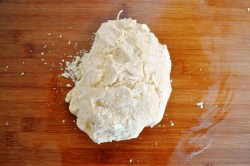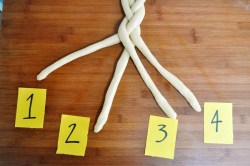Not being Jewish, I don’t have an iota of authority making challah, aka chollah, challa. But it’s a bread I love, and I’ve made a few times before, so I wanted to revisit it.
Quintessential for Sabbath and Jewish holidays, challah is not only a delicious enriched bread, a religious cousin to the secular brioche, it’s a great shape. I love the braid format, it’s handsome, fun to make and satisfying to tear.
I believe one of the reasons it’s a braid is that it’s easier to tear and as such doesn’t require cutting, thus avoiding introducing a knife – a weapon – to Sabbath and holiday proceedings.
I also believe the strands of the braid are symbolic of the Twelve Tribes of Israel. Being a pretty amateur braider, I’m not ready for a 12-strand version yet, so I am sticking with the more commonplace four-strand form. It’s not something I’ve done for a few years, so excuse any clunkiness in execution. Heck, I can’t even practice plaiting my wife’s hair, as she’s wearing it short at the moment.
Symbols and meanings
Talking of the symbolism and heritage of challah, I do get the impression that there are different interpretations. So while Alan Davidson in the Oxford Companion to Food writes, “… the meaning of the word challah in biblical Hebrew is this bit of dough, ‘the priest’s share’.” Claudia Roden writes, “The name challah was given to a bread in South Germany in the Middle Ages, when it was adopted by Jews for the Sabbath… John Cooper (Eat and Be Satisfied) notes that the first mention of the bread was in the fifteenth century and that the term was coined in Austria. Before that the bread was called berches, a name that is still used by Jews in some parts today.”
Other sources suggest berches – at least today – is a water-based challah, with potato in the dough. Fascinating. I love these baked-goods family trees.
Anyway, my challah is a dairy version. I’ve read about enough American-Jewish versions to know they exist, with butter instead of oil and milk instead of water, but not enough to understand the kosher restrictions. Indeed, none of my friends with Jewish heritage seem to understand these things either, so I shouldn’t kick myself too much for being an ignorant gentile in this case. Adapt as fits your requirements, eg replace the sugar with honey.
Recipe
As with all my recipes, it helps if you have electronic scales. And I use grams. They’re simply easier and more accurate. Plus, it’s the second decade of the 21st century, folks!
I’ve included baker’s precentages too, as they’re handy for conversions, scaling, comparisons etc.
This recipe uses a pre-ferment, a sponge. It’s a very pleasing technique, as you feed the yeast on some of the flour and some, or all of the liquid, and create what becomes a lively bubbling mass. Andrew Whitney also says it’s an important and useful technique for enriched doughs as “Yeast cannot feed on ingredients like fat, egg and spice, so it is a good idea to get it working vigorously before mixing it with these things.”
Make 2 medium sized, 4-braid loaves
Ingredients
| Ingredient | Percentage | Quantity (g) |
| White bread flour | 60 | 340 |
| Plain white flour | 40 | 225 |
| Milk | 42 | 240 |
| Yeast (fresh) | 2 | 12 |
| Egg | 20 | 110 |
| Salt | 1 | 6 |
| Butter | 12 | 70 |
| Caster sugar | 4 | 25 |
| Total | 181 | 1028 |
Notes
White bread flour – that is, higher protein.
Plain or all-purpose flour – that is, lower protein.
Use 6g of active dried yeast or 5g of instant yeast instead.
110g of beaten egg was exactly two medium eggs for me, though sizes vary. I wouldn’t agonise too much, bit more would be fine as it’s quite a dry dough.
Method
1. Warm up the milk and crumble in the yeast. In a medium bowl, mix the yeasty milk, the sugar and 200g of the white bread flour and beat together to make a slurryish mixture.
2. Cover and leave to get bubbly. This will take about an hour, depending on temperature. You could leave it in the fridge overnight.
3. In a large bowl, combine the plain flour, the remaining bread flour and the salt
4. The butter should be soft – at least at room temperature. If it’s not, warm it up a bit. I tend to nuke it for a few seconds in the microwave.
5. Crack a couple of eggs into a bowl, whisk briefly, then weigh out the necessary amount.


6. Put the butter, egg and sponge in the large bowl with the other flour and bring to a dough. Alternatively, just combine in a mixer with a dough hook, and form the dough.


7. If working by hand, turn out the mixture and knead until you have a smooth dough.

8. Form the dough into a ball, then put it in a large, clean bowl, cover and leave to prove until doubled in size. Time will vary depending on the air temperature but mine took about two hours.
9. Turn out the dough, then form it into a ball again. Leave to rest, covered, for five minutes.

10. Weigh the dough. It should weigh around 1000g. To make two medium loaves, divide it into eight pieces, each weighing about 125g. Alternatively, you can make one large loaf – just divide into four pieces, each weighing about 250g.
11. Form the pieces into balls, cover and rest for five minutes.

12. Form each ball into a snake or sausage or rope. You get the gist. Each needs to be the same length. Mine were 50cm, but I’m actually thinking it looks better if they’re shorter. Your choice.
13. Take four snakes and pinch one end of each together firmly, tucking the end under and laying the strands out in front of you like half a tired octopus.
14. There are plenty of videos online for braiding four strands. I remember it like this: 2/3, 4/2, 1/3 and repeat.
So take 2 (the second from the left) and put it over 3 (the third from the left), see above left. Then take 4 (the furthest right) and put it over 2 (the second from the left), see above right. Then take 1 (the furthest left) and put it over 3 (the third from the left).
Note, you’re not numbering the same strand itself, you’re numbering the position the strand is currently in, from left to right. Repeat to the end, then pinch together and tuck under again.


15. Put on a baking sheet, cover and leave to prove again until doubled in size.
16. Preheat the oven to 220C.


17. Brush the risen loaf with the remaining beaten egg. (At this point you can decorate it with seeds: poppy and/or sesame. Dip a wet knuckle in the seeds then press it onto a segment of the braid. Repeat until each segment has a patch of seeds on it.)

18. Put in the oven and bake for about 10 minutes, then lower the temperature to 180 and keep baking for another half hour or so. You want a nice golden colour.
19. Transfer to a wire rack and leave to cool completely.







Mouthwatering looking loaves Dan and beautifully plaited too, I have always struggled with four strands let alone twelve!! Recently enjoyed the Swiss equivalent – Butterzopf – while over in Wengen, one of my most favourites from there. Catherine
Will have to investigate butterzopf
wow, you are so clever – this is so perfect. Too lovely to eat 😉
Thanks very much. I think I’ll only really pat myself on the back when I manage a 12-strand one though!